Forests in art showcase seven universal symbols that reflect transformation and connection. You’ve got the Tree of Life, embodying growth and wisdom, and trees symbolizing resilience, illuminating personal journeys. Spiritual narratives, like the Bodhi Tree, celebrate awakening, while forests offer refuge for introspection. Artists use trees as metaphors for human experience, tapping into our inner worlds. Isn’t it mesmerizing how these symbols resonate in tattoo culture, too? Stick around to explore the deep-rooted connections even further!
Quick Takeaways
- The Tree of Life represents interconnectedness and personal growth across various cultures and artistic expressions through history.
- Forests embody transformation, symbolizing personal evolution and resilience amidst challenges in numerous art narratives.
- Sacred groves serve as conduits for spiritual reflection, linking ecological symbolism and cultural significance throughout art.
- Trees symbolize the dual nature of life, showcasing themes of death, rebirth, and spiritual awakening within historical artworks.
- Artistic depictions of trees highlight humanity’s intrinsic connection to nature and the cyclical nature of existence, emphasizing environmental stewardship.
The Tree of Life as a Universal Archetype
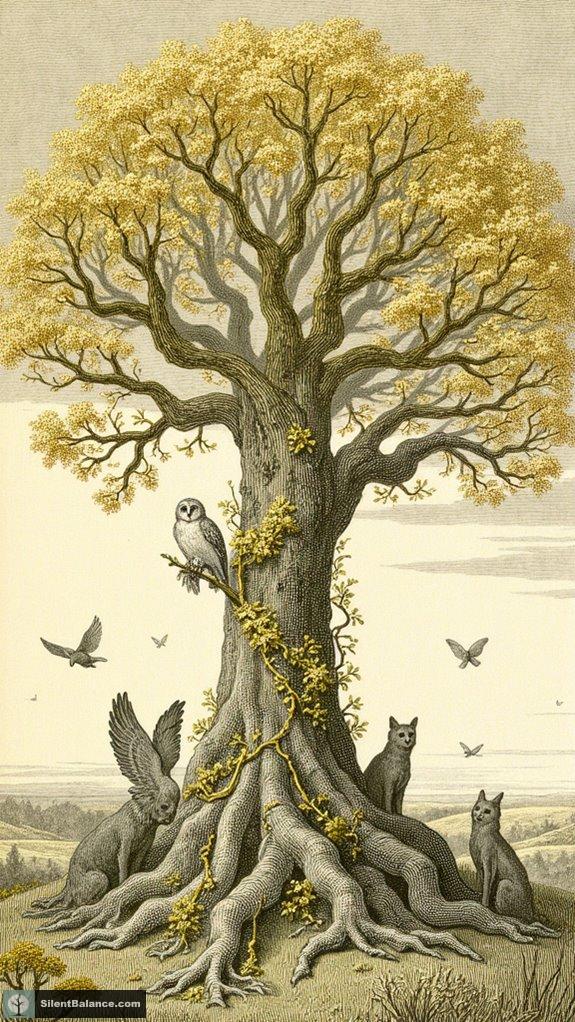
When you think about art that speaks to the core of human experience, odds are the Tree of Life pops into your head—like that iconic tattoo you saw on your buddy’s arm. This enduring symbol, dripping with archetypal interpretations, bridges gaps across cultures and ages.
You see, the Tree of Life embodies the cycles of existence, connecting domains from earth to the cosmos. Its roots ground us in our origins, while its branches elevate us towards growth and understanding. For example, the Yggdrasil in Norse culture signifies cosmic order, linking wisdom and knowledge and serves as a reminder of the interconnectedness of life that spans time and space.
What’s cooler than that?
Whether it’s a Celtic knot or Klimt’s golden leaves, each representation serves as a canvas for rich, cross-cultural symbolism. It’s a power play, a reminder of our interconnectedness in this wild journey called life.
Forest as a Symbol of Transformation and Growth
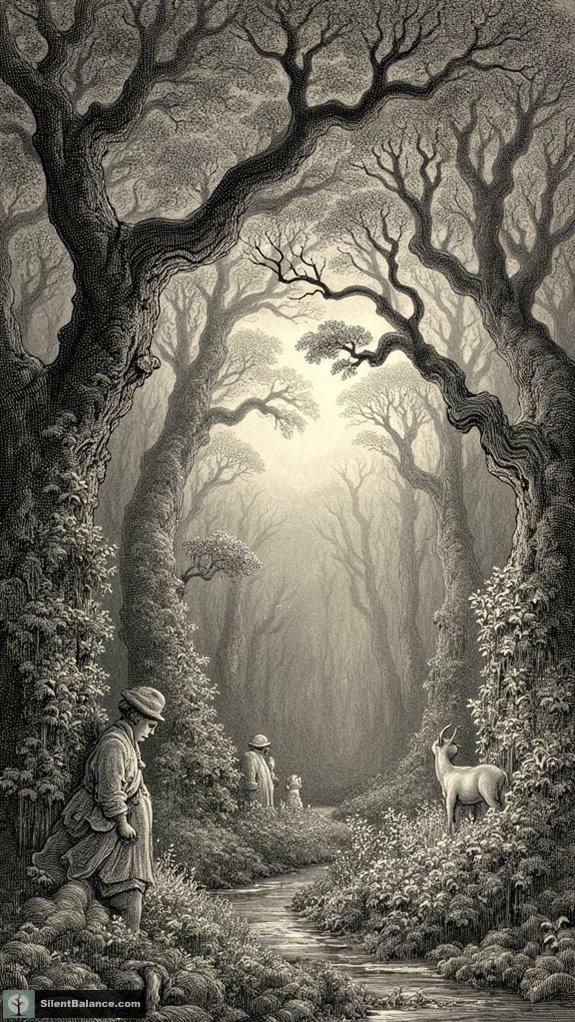
Envision this: you’re wandering through a vast, enchanting woodland, sunlight filtering through the leaves, whispering secrets of change and growth.
The forest stands as a powerful metaphor for your personal evolution, reminding you of the beauty in the journey through challenge.
Here are some mesmerizing perspectives into this transformative terrain:
- Inner Change: Forests embody the struggle of confronting your fears, pushing you toward growth.
- Liminal Spaces: Art illustrates these woods as places where you shift between states of being.
- Cycles of Life: Just like young trees erupt from the earth, resilience emerges from hardships.
- Freedom and Renewal: In the embrace of trees, you escape society’s constraints, rediscovering your core essence.
The wisdom of trees teaches us to embrace impermanence and change, allowing for personal transformation and deeper understanding.
Let this forest imagery deepen your appreciation for life’s complex dance.
The Role of Trees in Spiritual and Religious Narratives

Trees have always been more than just towering structures; they’re the ancient storytellers of our spiritual and religious narratives.
These magnificent beings often stand as sacred groves, representing ecological symbolism and the rich tapestry of cultural diversity.
Think about it—each tree is a conduit for spiritual communion, linking us to divine wisdom. Their mythological connections span centuries, appearing in artistic expressions across cultures.
Visual storytelling paints them as symbols of enlightenment and resilience.
Ever notice how trees often showcase life’s dual nature? They embody death and rebirth, reminding us of our continuous growth. The Bodhi Tree serves as a powerful reminder of this journey, symbolizing the potential for ultimate spiritual awakening.
As you engage with these symbols, you tap into a universal narrative—one that’s both empowering and deeply rooted in our shared human experience.
Isn’t that a wild thought?
Forests as Spaces of Refuge and Solitude
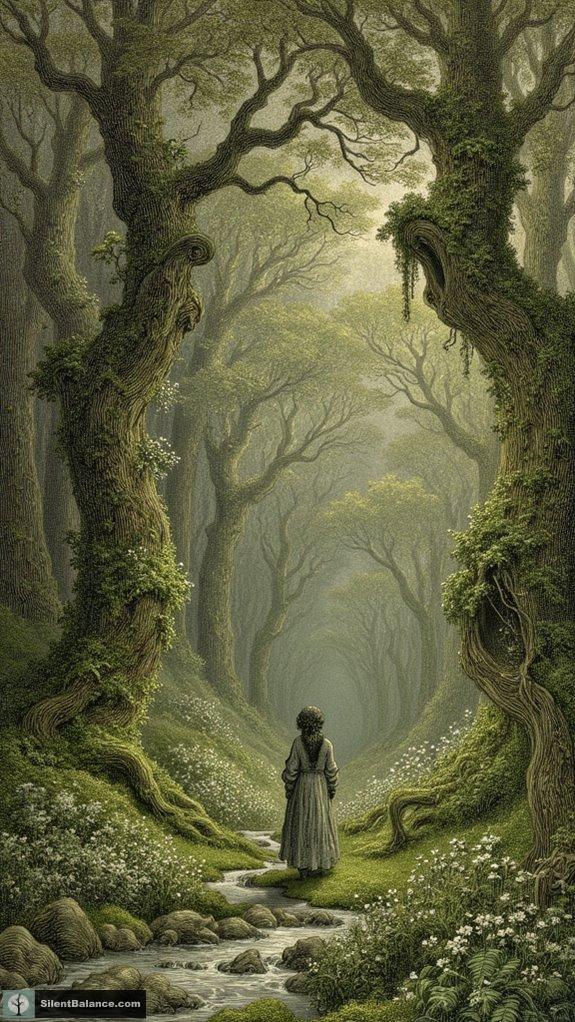
There’s something utterly magical about stepping into a forest, isn’t there? You’re welcomed by a world where forest solitude reigns, offering both refuge and inspiration.
Artists have long embraced these serene havens, depicting their soothing power through centuries of creative expression.
- Symbolism: Forests historically embody a sanctuary for deep reflection.
- Idealization: Wild inhabitants become noble figures, living simply and honestly.
- Isolation: Dense textures and organic shapes evoke a profound sense of meditative quiet.
- Introspection: Artists like Odilon Redon and Caspar David Friedrich portray solitude as a rich narrative, inviting you to explore your inner world. The willow tree’s symbolism reflects emotional and spiritual healing, captivating artists as they seek to capture nature’s profound effects on the human spirit.
In this lush environment, you find not just trees, but an artistic refuge waiting to release your muse.
Trees as Metaphors for the Human Experience
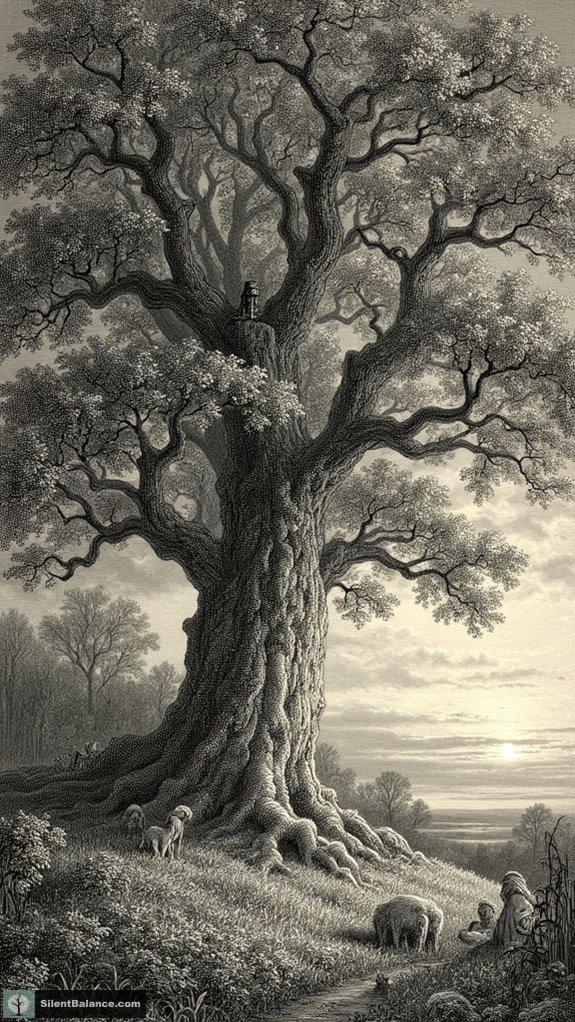
Envision walking through a vibrant forest, where towering trees whisper stories of growth, resilience, and interconnection.
You’ll find that tree symbolism captivates the essence of human growth, illustrating our life experiences from birth to maturity. Each ring within a trunk mirrors the passage of time, embodying our personal journeys.
Consider how trees endure harsh environments, showcasing resilience imagery we all aspire to possess. Through anthropomorphism in art, you see them depicted with human traits—strength, hope, and determination.
And let’s not forget family lineage; tree branches vividly symbolize our social connections, rooting us in shared heritage. Additionally, the Tree of Life serves as a powerful reminder of our interconnectedness and continuity within the broader human experience.
Symbolic Connections Between Trees and Identity
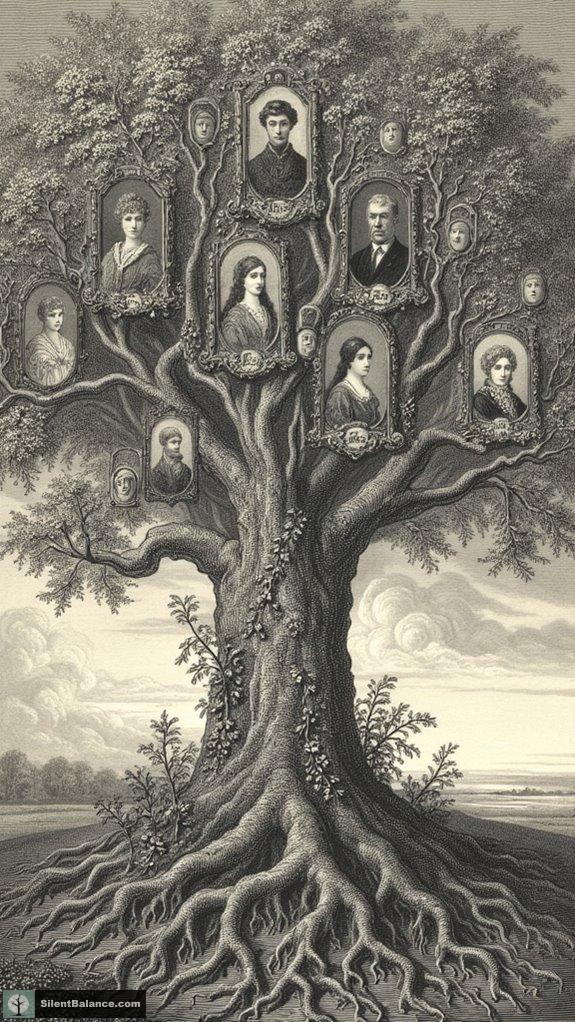
While you might think of trees primarily as just part of the scenery, they’re so much more than that; they’re living symbols that connect us all to our identities and shared histories.
Consider how trees symbolize our roots:
- Family Heritage: The classic family tree evokes deep ancestral connections, reminding us of who we are.
- Cultural Symbols: Different species embody unique cultural identities, creating a tapestry of collective memory.
- Resilience Imagery: Trees’ ability to flourish in adversity mirrors our own struggles, showcasing nature’s continuity.
- Spiritual Symbolism: Many beliefs tie trees to enlightenment, linking our identities to the divine. Additionally, the shared appreciation of trees throughout cultures highlights their role as symbols of unity in fostering familial bonds and collective identity.
The Evolution of Tree Imagery in Art History
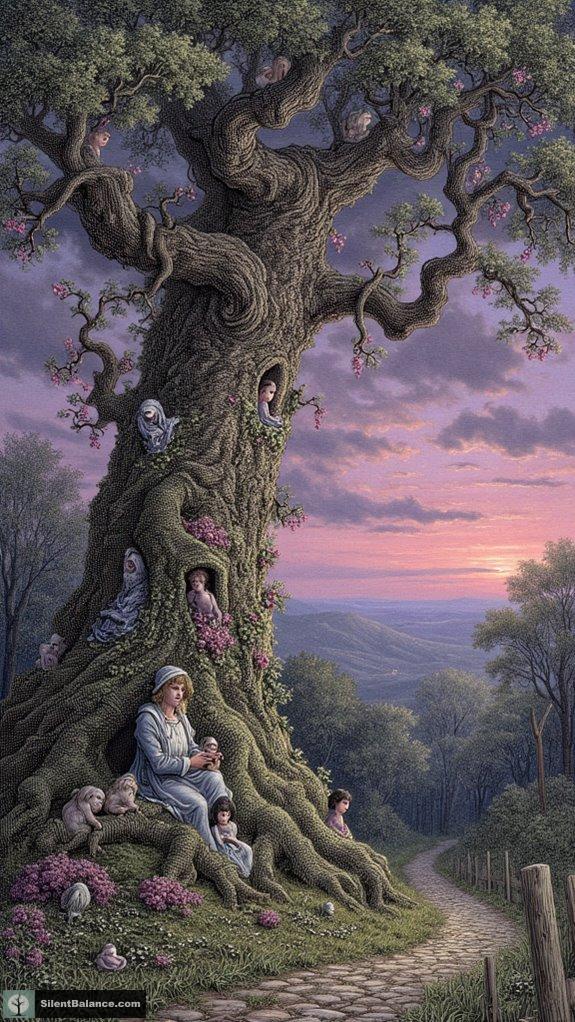
As you plunge into the world of art history, you’ll quickly realize that tree imagery has been an essential player in communicating complex ideas and emotions across different eras.
From ancient representations in cave paintings, where trees symbolized survival and spirituality, to the grand medieval and Renaissance works that blended them into religious narratives, trees have always held power.
Fast forward to the Barbizon School, where artists captured trees’ true essence through loose brushwork, and onward to the Romantic era, where they danced with emotion and mystique.
Today’s modern interpretations continue this evolution, mixing abstraction and dynamic form.
Isn’t it thrilling to witness how tree imagery transforms, reflecting humanity’s spirit through time?
Dive deep, and soak it all in—you’re part of this artful journey!
Tree of Life Variations in Art
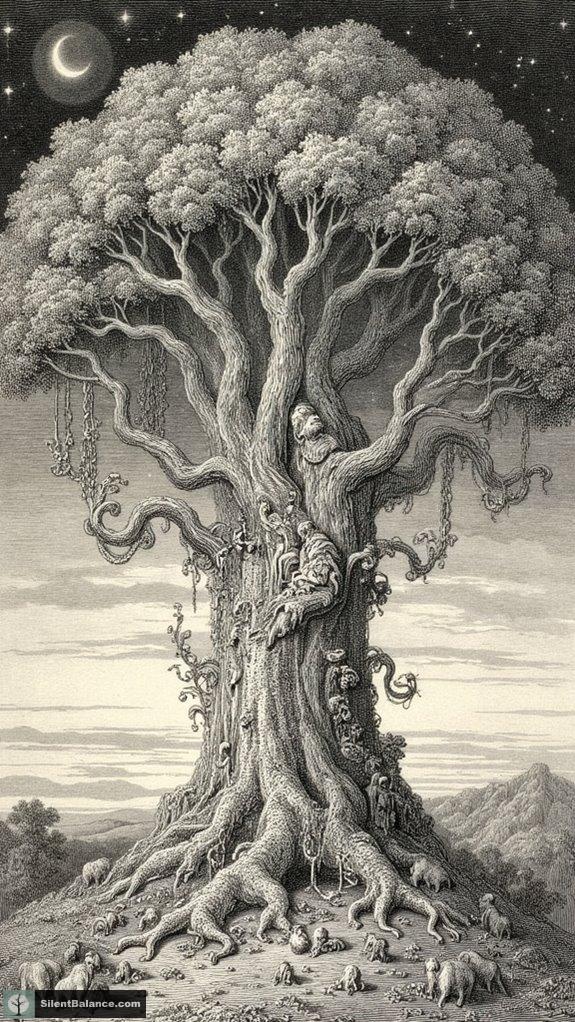
The Tree of Life has transcended cultures and eras, morphing into a vibrant tapestry of meanings and representations.
Its variations reveal a wealth of cultural interpretations, showcasing different artistic techniques that powerfully convey life’s complexities.
Here are four key adaptations you shouldn’t miss:
- Ancient Egypt saw it as eternal life, knitting cosmic order in tombs.
- India’s palampores burst with lush trees, symbolizing fertility and abundance.
- Celtic and Nordic traditions intertwine roots and branches, highlighting heaven, earth, and underworld connections.
- Gustav Klimt’s modern take dazzles with shimmering golds, infusing life cycles with opulence.
The Tree of Life symbolizes personal growth and continues to inspire individual journeys through its rich history and cultural significance.
Can you see how universally potent this symbol remains?
Embrace its magic, and let it inspire your own journey!
Collective Unconscious Tree Symbols Paintings
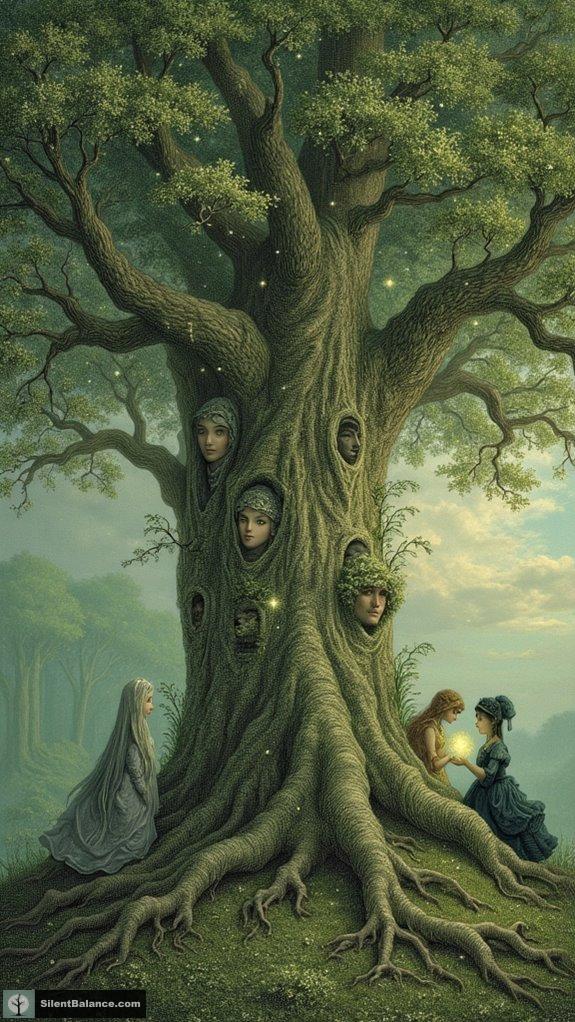
Ready to plunge into the vibrant world of Collective Unconscious Tree Symbols in paintings?
Imagine the power of artistic interpretation, where tree motifs spring forth as visual metaphors, tapping into our shared psyche. These aren’t just decorative elements; they embrace psychological symbolism, whispering age-old truths about growth and unity.
Evergreen imagery threads through sacred groves, inviting you to explore themes of rebirth and interconnectedness.
Artworks rich in these symbols resonate with ecological consciousness, reflecting our intrinsic bond with nature.
When you gaze upon these paintings, aren’t you struck by their ability to transcend time and culture?
The tree stands tall, a bridge between your personal experience and the collective unconscious, grounding you in a world that pulses with life and wisdom. Each depiction carries wisdom, enlightenment, and compassion, reinforcing the timeless significance of trees in the journey toward understanding our place within the universe.
Questions and Answers
What Influences Tree Symbolism in Different Cultures and Traditions?
Tree symbolism in various cultures shapes powerful connections to their beliefs and spirituality. Each culture sees trees as more than wood and leaves.
You’ve got the oak, standing tall as strength in Celtic lore, while the mighty Baobab serves as a communal hub in Africa.
Ever thought about how the Peepal tree brings peace in Hindu traditions?
Isn’t it fascinating how these living emblems connect you with nature, ancestors, and the divine? Trees are pure magic!
How Do Modern Artists Reinterpret Traditional Tree Symbols in Their Work?
In the vibrant world of modern art, you’re witnessing a fresh twist on those classic tree symbols.
Artists aren’t just slapping trees on canvas; they’re weaving modern reinterpretations that bring forth deeper symbolic connections.
Think of trees as bold statements about life, resilience, and our bond with nature—not just pretty backdrops.
Their work pushes you to reflect on your own existence, and it resonates like a well-inked tattoo, telling a story all its own.
Are There Specific Periods When Tree Imagery Became More Predominant in Art?
You’ve got to look at the Renaissance and Romantic periods to find tree imagery really taking root in art.
During the Renaissance, artists played with trees to symbolize life and resurrection, linking them to powerful narratives.
Then, in Romanticism, trees morphed into symbols of deep emotion and nature’s beauty, reflecting human existence’s complexities.
What Role Do Trees Play in Contemporary Environmental Sustainability Discussions?
Trees are pivotal in today’s environmental sustainability discussions, especially in urban forests. They’re not just pretty; they actively reduce heat, filter air pollutants, and help manage stormwater like nature’s original superheroes.
You can jump into practical conservation efforts by promoting green infrastructure in your community.
Ever thought about planting a few trees? You could literally transform cityscapes into cooler, healthier havens.
How Do Personal Experiences Shape Individual Interpretations of Trees in Art?
Did you know that 75% of people say personal experiences shape their emotional connections to art?
When you look at trees in artwork, your own tree memories—like climbing that old oak as a kid—come into play. Each branch and leaf may evoke feelings of nostalgia or resilience.
This subjective lens transforms what a tree represents to you, making it a dynamic symbol of growth, loss, and healing in your own narrative. Isn’t that powerful?
References
- https://art24.com/en/blog/the-forest-of-its-depiction-as-wilderness-mystery-and-place-of-idyll-to-the-resource-31A
- https://artdependence.com/articles/anselm-kiefer-symbolism-of-the-forest/
- https://www.lizbailey.org.uk/essays/wood-for-the-trees-in-contemporary-art
- https://ukrainianvintage.com/blogs/artisticwonders-unveiling-the-mysteries-of-masterpieces/from-roots-to-canvas-trees-as-the-key-to-symbolism-in-art
- https://ltfai.org/the-rich-symbolism-of-lithuanian-folk-art/
- https://luuckk.com/en-us/blogs/articles/meaning-tree-of-life-and-benefits-1
- https://www.lizthorne.com/tree-of-life/
- https://gettherapybirmingham.com/the-tree-of-life-a-universal-symbol-of-growth-connection-and-transformation/
- https://antrocom.net/wp/wp-content/uploads/2024/05/busatta-sandra-tree-of-life-design-2.pdf
- https://www.mozaico.com/blogs/news/art-and-the-ancient-secrets-of-the-tree-of-life
- 11 Scandinavian Pinecone Mantel Ideas - October 20, 2025
- 10 Simple Pinecone Twig Garland Crafts - October 19, 2025
- 15 Winter Pinecone Garland Ideas For Home - October 19, 2025

